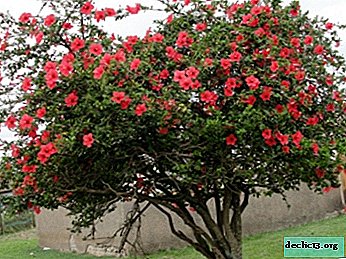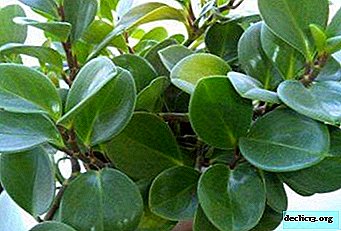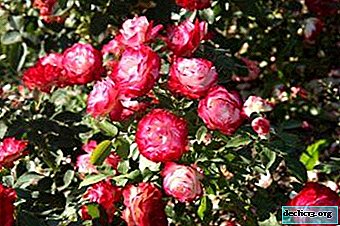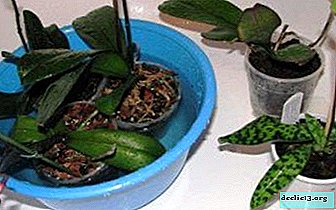Comparison of amaryllis and hippeastrum: description of plants, photos and differences
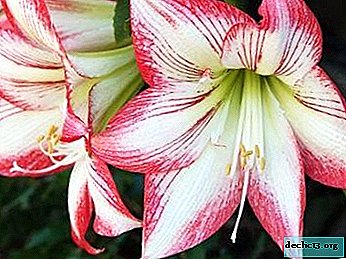
Amaryllis and hippeastrum are now popular indoor plants. Quite often they are confused among themselves all this because they are very similar in appearance.
These two plants are considered relatives, since they belong to the same family - amaryllis. Despite this, they are two completely different flowers.
The article describes the differences in colors, as well as photos and descriptions of how to distinguish them.
Definition and photo of flowers
The Amaryllis family, which includes amaryllis and hippeastrum, belongs to the class of flowering plants. These flowers have gained immense popularity as decorative. They can often be found as decorating flower beds or at home.
Color Definition:
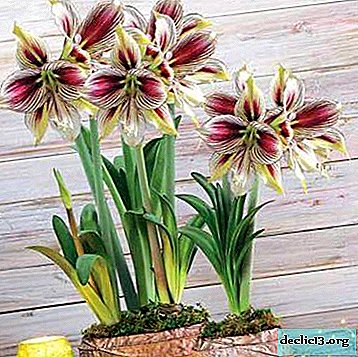 Amaryllis belladonna or, as it is otherwise called amaryllis beauty, is the only flower in this genus.
Amaryllis belladonna or, as it is otherwise called amaryllis beauty, is the only flower in this genus.It belongs to the class of flowering monocotyledonous plants. In Latin, its name sounds like Amarýllis belladónna. This flower, due to its excellent flowering, unpretentiousness in care and simple propagation, has gained popularity in all parts of the globe.
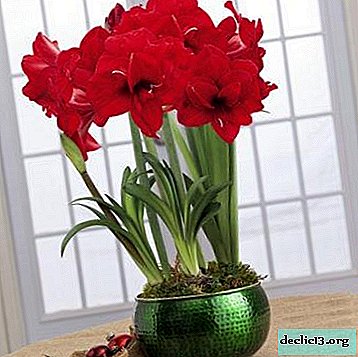 Hippeastrum or in Latin Hippeástrum is a bulbous flowering plant that belongs to the Amaryllis family, the genus of the Hippeastrum.
Hippeastrum or in Latin Hippeástrum is a bulbous flowering plant that belongs to the Amaryllis family, the genus of the Hippeastrum.He, like amaryllis, belongs to the class of flowering plants. The genus of this plant is represented by 90 species. A huge number of species were found in the Amazon basin, after which they spread to other tropical areas.
Why are they often confused?
The confusion between these genera of flowers began a long time ago and continues to this day - this is because:
- These plants are from the same family. Amaryllis was the first to be discovered, and a little later hippeastum, then scientists took it for one of the types of amaryllis. And only then after a time when they tried to cross and the attempts did not end with anything, scientists concluded that these are completely different plants.
- Both flowers are bulbous type and grew in a similar climate. Especially often they are confused by inflorescence, since both have an umbrella shape. At the same time, the flowering and dormant periods of these two plants are equally pronounced.
- Flower shops also confuse inexperienced gardeners with plant names. Some varieties of hippeastrum begin with the words amaryllis.
- Sometimes confusion occurs due to the fact that the hippeastrum blooms without leaves, such a flowering is not typical for him.
If you look at both flowers at once, they do not seem to be similar to each other, their differences are given out by the inflorescences and leaves themselves, but individually they are quite easy to mix up.
What is the difference?
The differences between these plants can be represented in the summary table:
| Differences | Amaryllis | Hippeastrum |
| Differences between childbirth | It belongs to the genus Amaryllis and is determined by only one species of Amaryllis belladonna. | It belongs to the genus hippeastrum. Today, there are about 90 species of this plant. |
| Differences in origin | The native land of the plant is southern Africa. | Originally from the tropics and subtropics of America. |
| Differences in appearance | It is an onion plant, the size of the bulb can reach 6-10 centimeters in diameter. The leaves are green. During flowering, leaves are absent. Inflorescences of this plant form 2-12 flowers, the size of which is approximately 7-10 centimeters in diameter, the flowers consist of 6 petals. Flowers are found in white, red, pink and purple. The stem of this plant is fleshy. | An onion plant, its bulb has the shape of a turnip 5-10 centimeters in size. The leaves of the plant are long green, their size, shape and shade completely depends on the species. This plant during flowering on the inflorescence can form from 2 to 5 flowers, 15-25 centimeters in diameter. Flowers have 6 petals. This plant, depending on the subspecies, has many colors of any shades. |
| The difference in growth and flowering | Amaryllis needs about 56 days to grow from seeds. At home, flowering occurs in autumn, the rest of the time the flower rests. | From seeds grows in two weeks. Flowering begins in winter and can continue until spring. |
| Differences in home care | It does not require special care. This flower does not like excessive humidity as it can become infected with fungal diseases. Before flowering, this plant must be at rest. To do this, in the summer it is put in a dark place. | This flower is not whimsical to care for. He does not like frequent watering. For good flowering for a month, it is necessary to give the plant peace, putting it in a dark place. |
How to distinguish correctly?
 Despite all the differences between these plants, amateur gardeners often confuse them.
Despite all the differences between these plants, amateur gardeners often confuse them.
Sometimes this becomes detrimental to the plant, because each of them has its own time of rest and flowering.
To prevent such errors, it is necessary to pay attention to the following differences when choosing a plant:
- In appearance.
It can be distinguished by color palette, number of flowers, and stem.
- By flowering period and its quantity.
Doubt should cause amaryllis blooming in winter. Hippeastrum during the flowering period can bloom several times, and amaryllis blooms only once.
- By smell.
Amaryllis flowers have a very pleasant aroma unlike hippeastrum, which has no smell.
- Bulb shape.
In amaryllis, the shape of the bulb is pear-shaped and covered with gray husk. In hippeastrum, the bulb has a round shape, the scales are similar to onion only in white.
The Amaryllis family unites these plants. It is very important to note that hippeastrum is much more common at home, and amaryllis in this regard is quite rare. Choosing one of these plants, you need to carefully consider it and take into account all the details, so that in the process of growth and flowering you will not make mistakes in care, which can lead to the death of the flower.

 Amaryllis belladonna or, as it is otherwise called amaryllis beauty, is the only flower in this genus.
Amaryllis belladonna or, as it is otherwise called amaryllis beauty, is the only flower in this genus. Hippeastrum or in Latin Hippeástrum is a bulbous flowering plant that belongs to the Amaryllis family, the genus of the Hippeastrum.
Hippeastrum or in Latin Hippeástrum is a bulbous flowering plant that belongs to the Amaryllis family, the genus of the Hippeastrum.




